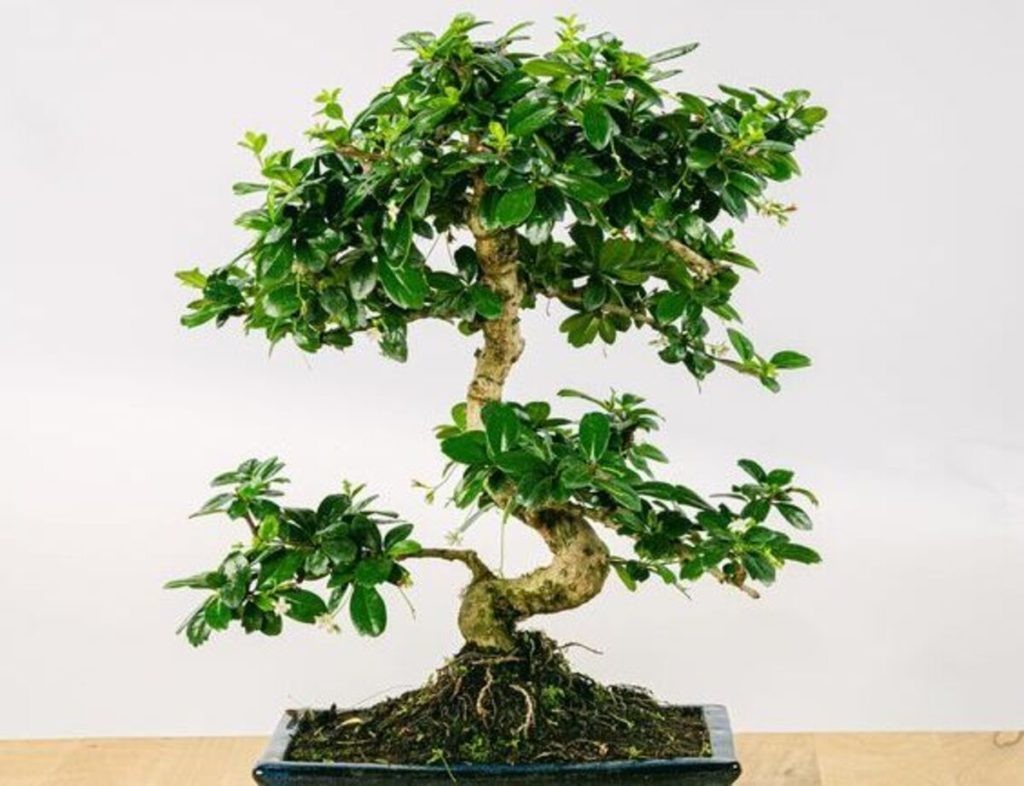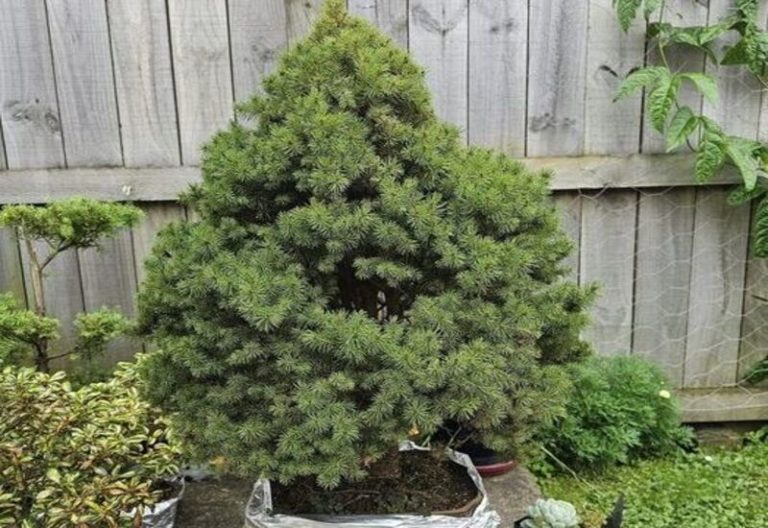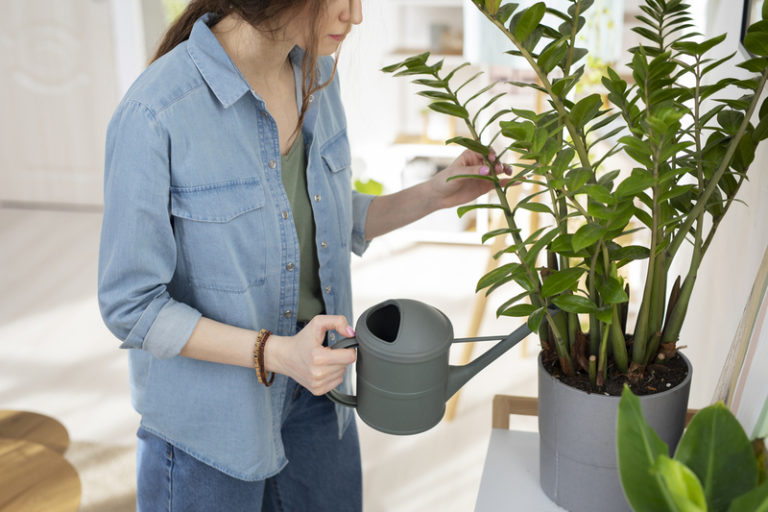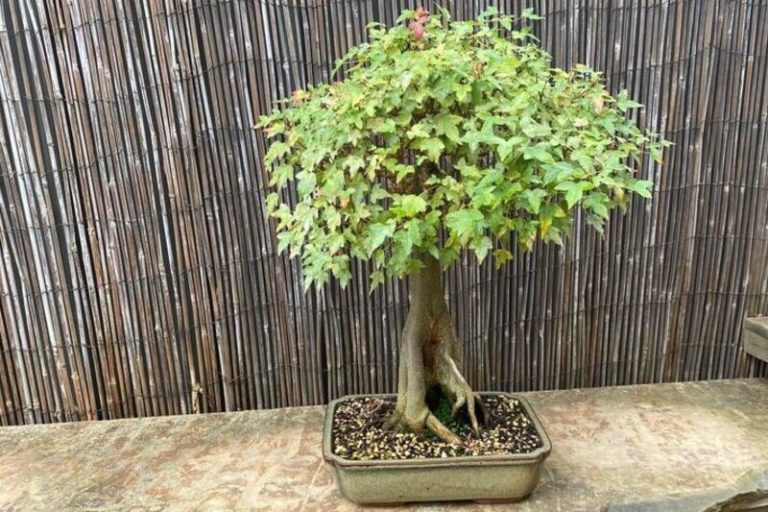Carmona Bonsai: A Symbol of Good Luck and Prosperity
Carmona bonsai is a type of small tree that is popular in the art of bonsai. It originated in China, but it is also commonly found in Southeast Asia. The tree is also known as Fukien tea bonsai, Philippine tea tree, or Carmona retusa. It is a beautiful and delicate plant that requires specific care and attention.
What is Carmona Bonsai?
Carmona Bonsai is a small tree that is commonly used in bonsai art. It has a thick trunk, dark green leaves, and produces small white flowers. It is native to China and Southeast Asia and requires specific care, such as being kept moist but not overwatered. It is a delicate plant that can be shaped into beautiful works of art with proper care.
History and Origins of Carmona Bonsai
The Carmona Bonsai, which is also called Fukien tea Bonsai , Philippine tea tree, or Carmona retusa, has been around since ancient China. Chinese bonsai artists started growing it as early as the Tang Dynasty (618-907 AD).
Carmona Bonsai was initially grown for its medicinal properties and was used to treat respiratory ailments. Over time, it became a popular plant for bonsai enthusiasts due to its unique characteristics and beautiful appearance.
The tree got its name from a town in Spain called Carmona, where it was first brought from the Philippines by Spanish traders. But the true home of the Carmona Bonsai is thought to be Southern China, where it can still be found growing in the wild.
The Carmona Bonsai was introduced to Japan in the early twentieth century, where it quickly became famous among bonsai artists. The Japanese refined the skill of cultivating and sculpting Carmona Bonsai, making it one of the most often utilized plants in bonsai art.
Carmona Bonsai is now cultivated and loved all over the world. It is still a popular choice for bonsai artists because to its distinct look, tiny size, and the difficulty in shaping and caring for the tree.
Types of Carmona Bonsai
Carmona Bonsai come in a variety of varieties, each with its own own traits and development patterns. Here are a few examples of the most prevalent types:
1. Standard Carmona Bonsai: This is the most common type of Carmona Bonsai and has a thick, gnarled trunk with dark green leaves. It produces small white flowers that bloom in the summer.
2. Shohin Carmona Bonsai: This is a smaller variety of Carmona Bonsai, usually no more than 8 inches tall. It is commonly used in smaller bonsai displays or as part of a collection.
3. Carmona Microphylla Bonsai: This type of Carmona Bonsai has smaller leaves than the standard variety, which makes it easier to shape and style. It is also more resistant to pests and diseases.
4. Carmona Fukienensis Bonsai: This is a taller variety of Carmona Bonsai, reaching up to 16 inches in height. It has smaller leaves and produces fragrant white flowers.
5. Carmona Macrophylla Bonsai: This Carmona Bonsai has bigger leaves than the normal version, making it a popular option among bonsai aficionados seeking a more dramatic impression.
Each type of Carmona Bonsai has its own unique characteristics and requires specific care and attention to thrive. Bonsai artists can choose the type of Carmona Bonsai that best suits their artistic vision and skill level.
Carmona Bonsai and Its Symbolism
Carmona Bonsai holds significant symbolism in various cultures and is known for its representation of peace, harmony, and longevity. It is also considered to bring good luck and prosperity to its owners.
In Chinese culture, Carmona Bonsai is a symbol of long life, balance, and harmony. The Chinese also believe that it brings good luck to its owners and wards off negative energy.
Carmona is a bonsai artist. Bonsai is usually used to signify harmony and balance. Its twisted and gnarled branches reflect life’s hurdles and trials, yet its delicate leaves and exquisite blossoms represent the beauty and peace that may be discovered in the middle of such hardships.
Carmona Bonsai is also often used in Feng Shui, an ancient Chinese practice of arranging objects and space to promote balance, harmony, and prosperity. Placing a Carmona Bonsai in the wealth area of a home or office is believed to attract financial abundance and success.
Overall, Carmona Bonsai is highly regarded for its symbolism in various cultures, representing balance, tranquility, and prosperity.

Characteristics of Carmona Bonsai
Carmona Bonsai is a popular choice for bonsai enthusiasts due to its unique characteristics. Here are some of the notable features of Carmona Bonsai:
Leaves: Carmona The leaves of a bonsai are dark green, glossy, oval-shaped, and pointed at the tip. The tiny and delicate leaves make them ideal for bonsai growth.
Flowers: During the summer, this bonsai produces little white flowers. The blossoms have a pleasant aroma and contribute to the tree’s charm.
Trunk: The dense, contorted trunk of the Carmona bonsai contributes to its aged and mature appearance. The bark has a grayish-brown hue and an uneven surface.
Growth Pattern: Carmona Bonsai has a dense and compact growth habit, making it a great choice for smaller bonsai displays. The tree grows slowly and can be shaped and styled according to the bonsai artist’s vision.
Care Requirements: Carmona Bonsai requires a specific care regimen to thrive. It prefers bright, indirect light, well-draining soil, and regular watering. It is also important to protect the tree from extreme temperatures, drafts, and pests.
Carmona Bonsai has distinctive qualities that make it a popular option among bonsai enthusiasts. Its tiny, delicate leaves, twisted trunk, and fragrant blossoms contribute to its beauty and appeal. With proper care and attention, Carmona Bonsai can flourish and offer its owner years of happiness.
How to Grow Carmona Bonsai
Growing a healthy and beautiful Carmona Bonsai requires attention to detail and proper care. Here are some steps to help you grow a thriving Carmona Bonsai:
- Choose the Right Soil and Pot: Carmona Bonsai necessitates nutrient-rich, well-draining soil. To create an ideal growing environment, use a soil mixture containing peat moss, perlite, and grit. To accommodate for growth, choose a container that is marginally larger than the root ball.
- Watering: Carmona To maintain robust growth, bonsai must be watered regularly. Water the bonsai when the soil becomes dried to the touch, but avoid overwatering, as this can cause root decay. Regularly examine the soil to determine when it needs to be watered.
- Light: Carmona Bonsai prefers bright, indirect light. Place the bonsai near a window that receives filtered light or use artificial lighting to supplement natural light. Avoid exposing the bonsai to direct sunlight for extended periods, as this can cause leaf burn.
- Fertilizer: Carmona Bonsai requires regular fertilization to maintain healthy growth. Use a balanced fertilizer every four to six weeks during the growing season. Follow the instructions on the fertilizer packaging to determine the appropriate amount to use.
- Pruning and Shaping: Regular pruning and shaping are essential to maintain the bonsai’s size and shape. Use sharp bonsai tools to remove any unwanted branches and foliage, and shape the tree according to your desired style.
- Repotting: Carmona Bonsai should be repotted every two to three years to promote healthy growth. Repot the bonsai in fresh soil and trim the roots to encourage new growth.
By following these steps, you can grow a healthy and beautiful Carmona Bonsai that will bring joy and tranquility to your home or office. Remember to be patient and consistent with your care, and your bonsai will thrive for many years to come.
Benefits of Carmona Bonsai
Carmona Bonsai is not only a beautiful decorative plant, but it also offers several benefits for the grower and the environment. Here are some of the benefits of Carmona Bonsai:
1. Aesthetic Appeal: Carmona Bonsai adds a touch of elegance and beauty to any indoor or outdoor space. It can enhance the ambiance of your home or office and create a calming and relaxing atmosphere.
2. Stress Relief: Taking care of Carmona Bonsai can be a therapeutic and stress-relieving activity. Caring for plants has been shown to lower stress levels and improve mood.
3. Air Purification: Carmona As with other plants, bonsai contribute to air purification by removing hazardous contaminants and pollutants. It absorbs carbon dioxide and releases oxygen, purifying and revitalizing the air.
4. Relaxation: Carmona Bonsai is a perfect plant for meditation and relaxation. Its natural beauty and serene appearance can help soothe your mind and promote relaxation and calmness.
5. Learning and Education: Growing Carmona Bonsai can be an educational experience, especially for children. It can teach them about plant care, patience, and responsibility.
6. Gift-Giving: Carmona Bonsai is a considerate and unique present that can bring the recipient pleasure and happiness. It is a wonderful method to express appreciation, affection, and caring.
Overall, Carmona Bonsai provides numerous advantages for both the cultivator and the environment. It is a gorgeous and versatile plant that can improve many aspects of your life.

Styling and Design of Carmona Bonsai
Styling and designing Carmona Bonsai is an art that requires patience, creativity, and attention to detail. Here are some tips on styling and designing your Carmona Bonsai:
Choose the Right Style: Carmona Bonsai can be styled in various ways, including formal upright, informal upright, slanting, cascade, semi-cascade, and literati. Choose a style that suits your preferences and the environment where the bonsai will be placed.
Create a Focal Point: Select a front view for your Carmona Bonsai that highlights the tree’s best features. This will create a focal point and draw the viewer’s attention to the bonsai’s unique characteristics.
Use Branch Wiring: Wiring the branches of your Carmona Bonsai can help you create the desired shape and form. Use copper or aluminum wire to wrap around the branches and bend them into the desired shape. Be careful not to wire too tightly or for too long as this can cause damage to the tree.
Use Pruning Techniques: Pruning is essential to maintain the shape and size of your Carmona Bonsai. Use scissors, shears, or concave cutters to remove unwanted branches and foliage. Prune the bonsai regularly to encourage new growth and maintain its form.
Add Decorative Elements: Decorative elements such as rocks, moss, and figurines can enhance the overall look and feel of your Carmona Bonsai. Use these elements sparingly and in a way that complements the bonsai’s natural beauty.
Carmona Bonsai can be a fun and satisfying thing to style and create. With the right skills and attention to detail, you can make a beautiful and unique bonsai that will bring joy and peace to your home or office.
How to Care and Maintain Carmona Bonsai
Caring and maintaining Carmona Bonsai is essential to keep it healthy, beautiful, and thriving. Here are some tips on how to care and maintain your Carmona Bonsai:
- Watering: Always give your Carmona Bonsai some water, but not too much. The ground should be wet but not soaked. Touch the soil to see how moist it is, and only water the bonsai when the soil feels dry.
- Soil: Use well-draining soil for your Carmona Bonsai to prevent waterlogging and root rot. A mixture of bonsai soil, perlite, and sand can work well.
- Fertilizer: Fertilize your Carmona Bonsai regularly with a balanced fertilizer during the growing season (spring and summer). Reduce the frequency during the dormant season (fall and winter).
- Lighting: Carmona Bonsai prefers indirect yet strong light. Place the bonsai near a window where it will get enough light, but keep it away from direct sunshine, which will burn the leaves.
- Temperature and Humidity: Carmona Bonsai flourishes in a warm, humid climate. Maintain a temperature of 65-75°F (18-24°C) and a humidity level of 50-60%.
- Pruning and Wiring: Prune and wire your Carmona Bonsai regularly to maintain its shape and form. Remove any dead or damaged branches, and wire the branches into the desired shape.
- Pest Control: Watch out for pests such as spider mites, scale insects, and mealybugs, which can infest Carmona Bonsai. Use organic or chemical pest control methods to get rid of them.
Caring and maintaining Carmona Bonsai requires patience and diligence, but the rewards are worth it. A well-cared-for Carmona Bonsai can live for many years and provide you with beauty, tranquility, and joy.
Carmona Bonsai care sheet
| Aspect | Care Tips |
| Watering | Water regularly, but don’t overwater. Check soil moisture before watering. |
| Soil | Use well-draining soil to prevent waterlogging and root rot. |
| Fertilizer | Fertilize regularly during the growing season with balanced fertilizer. |
| Lighting | Provide bright but indirect light. Protect from direct sunlight. |
| Temperature/Humidty | Maintain temperature between 65-75°F (18-24°C) and humidity at 50-60%. |
| Pruning/Wiring | Prune and wire regularly to maintain shape and form. |
| Pest Control | Watch for pests and use organic or chemical control methods to get rid of them. |
These are just brief care tips for each aspect of caring for Carmona Bonsai. It’s important to research and learn more about each aspect to ensure proper care for your bonsai.
Conclusion
Carmona bonsai is a beautiful and delicate tree that requires specific care and attention. It is essential to provide the right climate, soil, and nutrients for the tree to grow successfully. With proper care, Carmona bonsai can be shaped into a work of art that will provide years of enjoyment.
FAQ:
Q: How often should I water my Carmona Bonsai?
A: Water your Carmona Bonsai regularly, but be careful not to overwater it. Check the soil’s moisture level by touching it with your finger, and water the bonsai only when the soil feels dry.
Q: What type of soil should I use for my Carmona Bonsai?
A: Use well-draining soil for your Carmona Bonsai to prevent waterlogging and root rot. A mixture of bonsai soil, perlite, and sand can work well.
Q: How often should I fertilize my Carmona Bonsai?
A: Fertilize your Carmona Bonsai regularly with a balanced fertilizer during the growing season (spring and summer). Reduce the frequency during the dormant season (fall and winter).
Q: How much light does my Carmona Bonsai need?
A: Carmona Bonsai prefers indirect, strong light. Place the bonsai near a window where it will receive adequate sunlight, but shield it from direct sunlight, which can cause the foliage to burn.
Q: What temperature and humidity levels are best for Carmona Bonsai?
A: Carmona Bonsai thrives in a warm and humid environment. Maintain the temperature between 65-75°F (18-24°C) and humidity around 50-60%.
Q: How do I prune and wire my Carmona Bonsai?
A: Prune and wire your Carmona Bonsai regularly to maintain its shape and form. Remove any dead or damaged branches, and wire the branches into the desired shape.
Q: How do I protect my Carmona Bonsai from pests?
A: Carmona Bonsai can be infested with parasites such as spider mites, scale insects, and mealybugs. Utilize organic or chemical pest control to eliminate them.
Also Read:








